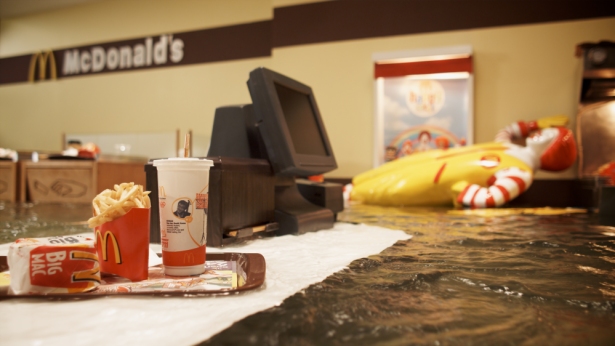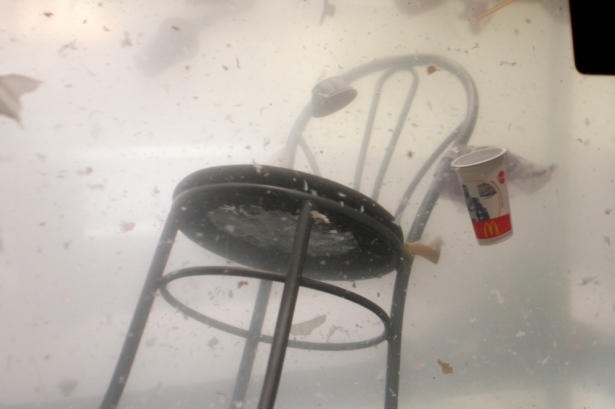This post comes from the Artists and Climate Change Blog
The second in a year-long series on artists who are making the topic of water a focus of their work and on the growing number of exhibitions, performances and publications that are popping up in museums, galleries and public spaces around the world with water as a theme.
Flooded McDonald’s
Although created nine years ago by the Danish three-man art collective Superflex, the haunting film Flooded McDonald’s is every bit as relevant today, if not more so, as we recall with horror the recent television coverage of unprecedented water damage caused by mega-hurricanes Harvey, Irma, and Maria in Texas, Florida, and the Caribbean. Just 21 minutes in length, Flooded McDonald’s was produced by Propeller Group (Ho Chi Minh City) in association with Matching Studio (Bangkok), and co-produced by the South London Gallery, the Louisiana Museum of Modern Art (Denmark) and Oriel Mostyn Gallery (Wales).
Superflex
Superflex, founded in 1993 by Bjornstjerne Christiansen, Jakob Fenger, and Rasmus Nielsen, calls their art projects “tools†that they feel can be used in many ways and in many contexts beyond the art world. As they describe it, Superflex “challenges the role of the artist in contemporary society and explores the nature of globalization and systems of power… with art work that addresses serious social and cultural concerns.†In Flooded McDonald’s, Superflex has taken on the topic of rising tides, a now-uncontested result of global warming, using a life-size replica of a McDonald’s restaurant that gradually floods with water. The British art critic Charles Darwent summarized the film by stating: “Imagine if a rising tide caused by global warming claimed the very thing that contributed to it.â€
The Set
The set of Flooded McDonald’s was created in meticulous detail over a two-week period in an empty swimming pool in Bangkok, Thailand. Eerily devoid of staff or customers, it includes a fiberglass, life-size Ronald McDonald, real Big Macs, counters, freezers, banquettes, hundreds of paper cups, cardboard hamburger containers, fries, sodas, napkins, trays, signage and all the accoutrements of the real thing. For 21 minutes, the restaurant is gradually flooded with 80,000 liters or 21,000 gallons of water.

Still image from the film Flooded McDonald’s. Courtesy of Superflex.
What Happens
At first, the water seeps in slowly under the door. The accompanying sound track is similar to the sound of the gentle lapping of the sea against the shore. Gradually, the level of the water rises, taking with it everything in its path. But even as the rising water fills the space, the scene is not what we expect of a forceful, full-fledge flood. As Superflex describes it, the film portrays a flood that is “destructive but in a mild, Scandinavian way.â€
Although the artists admit that they scripted most of the shots for the film, in the end, the water “does what it wants,†creating unexpected and sometimes ironic images: the fiberglass sculpture of Ronald McDonald topples over and waves to the camera, bringing to mind the iconic image of Saddam Hussein’s statue, arm upraised, crashing to the ground in Baghdad and marking the end of an era; a plastic sign reading “wet floor†floats by, an understated reference to the way in which many government leaders have purposely underestimated the dangers of global warming.

Production image from the film Flooded McDonald’s. Courtesy of Superflex.
The random beauty amidst the destruction is evident throughout the film. With its ability to reflect what is above and below the surface, water is its own work of art. Camera shots taken underwater reveal a murky world where oil, French fries, paper debris, bits of food, and even furniture form pleasing shadows and abstract images.

Still underwater image from the film Flooded McDonald’s. Courtesy of Superflex
So What Does It All Mean?
In a video titled Why We Flooded McDonald’s, created by the Louisiana Channel, a non-profit website based at the Louisiana Museum of Art in Humlebaek, Denmark, the Superflex artists “walk†the viewer through the film and talk about their artistic intentions.
In their narration, the artists describe the film as an “end of the world scenario,†a “conversation†on global warming that uses the most famous fast-food chain in the world as a powerful symbol of corporate greed and consumerism. In what to me is a brilliant metaphor for climate change in general and rising tides in particular, they state that “when you add water, you can’t move backwards from what it does.†Like climate change itself, once unleashed, flood water destroys everything in its path.
In preparation for writing this post, I sent an email to Superflex asking them how they feel about the film nine years later. I received the following response: “Flooded McDonald’s hints at the consumer-driven power and influence and impotence of large multinational companies in the face of climate change, questioning with whom ultimate responsibility lies.â€
Where to see Flooded McDonald’s
If you are lucky enough to live in the Los Angeles area, you can watch the film at UCLA’s Hammer Museum through October 15. Otherwise, check out the Louisiana Channel video Why We Flooded McDonald’s for film clips and commentary by the artists or watch a brief film clip here.
(Top image: Still image from the film Flooded McDonald’s. Courtesy of Superflex.)
About Artists and Climate Change:
Artists and Climate Change is a blog that tracks artistic responses from all disciplines to the problem of climate change. It is both a study about what is being done, and a resource for anyone interested in the subject. Art has the power to reframe the conversation about our environmental crisis so it is inclusive, constructive, and conducive to action. Art can, and should, shape our values and behavior so we are better equipped to face the formidable challenge in front of us.


